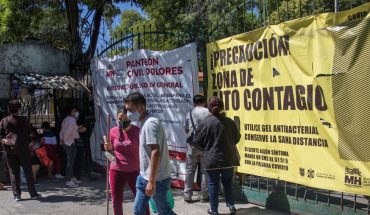About 11,000 years ago something unprecedented happened in the last 100,000 years of Earth’s history: the planet’s climate became stable.
This geological era with predictable temperatures was baptized as Holocene and it allowed humanity to develop agriculture, domesticate animals, and basically create today’s modern world.
However, in that process we also extinguish species and damage ecosystems, pollute the air, water and soil, and unleash the climate change crisis.
In other words, we force entry into the Anthropocene, the current geological era where humans are primarily responsible for changes on the planet.
It is in this context that an international group of scientists led by Swede Johan Rockström of the Stockholm Resilience Centre began to investigate what risk we run of breaking the Earth’s natural balance and resilience.
Their influential study, published in 2009, defined nine interconnected boundaries or parameters that are Determinants to maintain the stability of the planet.
“Each of those aspects is very important individually, but also it is very important to see them with the whole“Arne Tobian, a researcher at the centre, tells BBC Mundo.
In addition to identifying these nine processes, the experts defined very specific quantitative measures for each of them, which delimit a safe zone of action and one of risk, which in turn is growing in danger.
If we don’t cross those borders Humanity will be able to continue to thrive for generations.
But andn case of passing only oneto of these, we expose ourselves to generating irreversible environmental changes throughout the system and triggering the collapse of our society.
The results of this colossal study were brought to the screen in a recent Netflix documentary titled “Breaking the Boundaries: The Science of Our Planet”” and has become especially relevant in the framework of the 26th United Nations Conference on Climate Change (COP26), whose objective is to achieve that the world will act quickly in the face of a crisis that has been known for decades and whose scope for action is shrinking.
THE 9 LIMITS PLANETARY
Of the nine planetary boundaries, we have already crossed four, there are three within the safe zone (for now) and two that are still a big unknown.
1. Climate change
One of the four limits we have already exceeded is perhaps the best known of all: climate change.
Since the Industrial Revolution, global temperature has risen 1.1°C. This increase is responsible for the extreme weather events that are increasingly occurring throughout the world, such as droughts and floods.
According to the United Nations (UN), today we have five times more weather disasters than in 1970 and are seven times more costly. The consequences are more devastation and more deaths.
The scientific community affirms that, to avoid that the consequences of climate change are even worse, it is necessary that the increase in temperature is maintained in the vicinity of 1.5ºC.
Droughts such as the current one of the Paraná River that affects several countries in South America are increasingly frequent due to climate change.
However, if we continue as we do today, by the end of this century. the increase can reach 4.4°C, which would be catastrophic.
“The drama is that the challenge of climate change may be the easiest (to solve) if you look at the challenge of sustainable development as a whole,” Rockström said in presenting his study at a TED talk in 2010.
As if that were not enough, climate change is one of the two planetary boundaries considered central for its influence on the entire system.
2. Biosphere integrity
The integrity of the biosphere, that is, the loss of biodiversity and extinction of species, is the other of the central limits. And we’ve been through it too.
However, unlike climate change, this process has already passed the increasing risk zone and is directly in the high risk zone, which increases thetheft of generate irreversible environmental changes on a large scale.
So much has been exceeded that some researchers believe that we are in the midst of the sixth mass extinction in the history of the planet.
To get an idea, mass extinctions were periods where 60 to 95% of species were wiped out.
One million animal and plant species are now in danger of extinction.
In the Netflix documentary, Rockström says that we should lose zero biodiversity and species from next year.
The challenge is monumental if one takes into account that currently of the 8 million animal and plant species that inhabit the planet, 1 million is in danger of extinction.
However, it is a necessary effort: having healthy ecosystems provides us with clean air, fertile soils, fresh water, pollinated crops, raw materials for new drugs and a long etcetera.
3. Land use change
Land use is another of the boundaries that we have crossed and consists of the transformation of forests, grasslands, wetlands, tundra and other types of vegetation mainly in land for agriculture and livestock.
Deforestation, for example, has a huge impact on the climate’s ability to regulate itself, something that specialists repeat every time there are fires in the Amazon.
But land-use change is also one of the drivers of severe reductions in biodiversity, not least because of the growing demand for land to produce food.
In fact, one of the current challenges of sustainability is how to feed the nearly 8 billion people living on the planet (and the 2 billion more that will be in 2050) without taking more land away from nature.
4. Biochemical flows
The fourth and last frontier already overcome is that of biochemical flows, which mainly covers the phosphorus and nitrogen cycles.
Agriculture accounts for 70% of the planet’s freshwater use.
While both elements are essential for plant growth, their excessive use in fertilizers puts them in a risk zone.
One of the problems this generates is that some of the phosphorus and nitrogen applied to crops is washed into the sea, where they push aquatic systems to cross their own ecological thresholds.
5. Stratospheric ozone reduction
Of the nine processes, there are only one on which humanity acted successfully by seeing the warning signs: ozone reduction in the stratosphere.
More than 30 years ago the whole world agreed on forbid chlorofluorocarbons (CFCs), chemicals that were causing a “hole” in the ozone layer.
The consequences of losing this layer of protection ranged from the multiplication of skin cancer cases to irreversible environmental damage.
The Montreal Protocol in force since 1989 banned the use of certain substances to protect the ozone layer, vital to curb ultraviolet radiation from the Sun.
After the famous Montreal Protocol, stratospheric ozone has been recovering, which today allows us to be calm within the safe zone for this process.
6. Use of fresh water
While freshwater use is currently within the safe action area, we are moving in a dizzying way towards the risk zone, says Rockström in the documentary.
It’s that the Earth can be seen as a blue dot from space, but alone 2.5% is fresh water. This percentage is decreasing mainly due to the aforementioned increasing pressure from agriculture to produce more and more food.
It should be noted that although desalination is possible, it consumes a lot of energy that, in general, comes from the same fossil fuels that contribute to climate change. As if this were not enough, this process is a source of pollution of coastal ecosystems.
7. Ocean acidification
Something similar happens with ocean acidification as with fresh water: the limit has not been crossed yet, but we are dangerously close.
The bleaching of corals exposes them to disease and has already sparked mass death events of these organisms throughout the world.
The problem is that its effects are just hidden underwater, for example, with the death of corals.
This particular process features an ext layerRisk ra, then several of history’s mass extinctions had ocean acidification as a trigger..
Over the past 200 years, ocean water has become 30% more acidic, a rate of chemical transformation 100 times faster than that recorded there in the past 55 million years.
This limit is so intimately linked to climate change that it is often called its “evil twin”.
The good news is that if the climate change targets ratified at COP26 are met, the pH of the ocean will remain at bay.
8. Atmospheric aerosol load
There are still two boundaries to mention that are not on either side of the border. And it is that scientists don’t know how to measure them.
“There is no baseline of the last 11,000 years for these processes, because they are new,” Tobian explains.
Breathing highly polluted air is responsible for some 800,000 premature deaths each year.
One of them is the contamination of the atmosphere with aerosols of human origin, that is, microscopic particles generated mainly by the burning of fossil fuels, but also for other activities such as forest fires.
These aerosols affect both climate (for example, they cause changes in monsoon systems in tropical regions) and living organisms (about 800,000 people die prematurely each year from breathing highly polluted air).
9. Incorporation of new entities
The ninth and final process is the incorporation of so-called “new entities”.
These are elements or organisms modified by humans, as well as entirely new substances. This includes a list of hundreds of thousands of entities that go from radioactive materials to microplastics.
But perhaps the best example is CFCs, that is, those chemicals that were banned to save the stratospheric ozone layer.
Hope as action
The work of the Stockholm Resilience Centre not only warns about the core issues affecting the planet. Also gives hope.
“We know what the problem is and we know we have a problem and also at the same time we know what the possible solutions would be. We have it at hand“Tobian tells BBC World.
The challenge is big and pressing: in this decade ending in 2030 humanity must carry out a massive transformation to stay in line.
However, scientists say it is possible.





